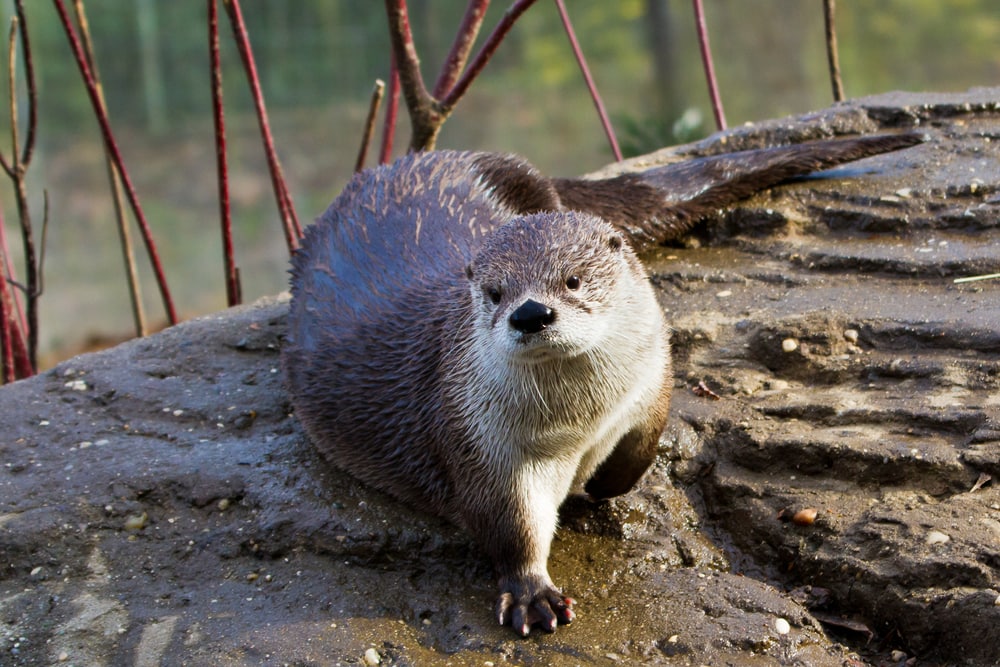The study of living organisms and their environments?
Ecology
Name 3/5 basic needs that all living things require to survive.
Water, nutrients, exchange of gases, energy, and suitable living conditions.
Name one way that biotic and abiotic factors are interacting in the following picture:

Otter on rock, otter and weather, plants and water, etc.
Name the 2 types of succession and give an example of when each would happen.
Primary- after a volcanic eruption
Secondary- forest fire, abandoned farmland
Mercury appearing in ecosystems is an example of what?
Bioaccumulation
Term referring to non-living components of an ecosystem?
Abiotic
Name the two types of adaptations, give an example that a rhinoceros might have for both.
Behavioural (herds)
Physical (horns)
Habitat- wooded, treed area.
Niche- where it lies in the food chain, adaptations, habitat, etc.
What is pesticide used for? Name an unintended consequence that might occur as a result off using them.
Killing pests. Consequences might include killing insects or animals that aren't pests, affecting many different members of a food chain by removing a pest species, and polluting water and soil.
"an animal that is very sensitive to changes in their habitats"
What is this describing and what is an example of it?
Indicator species- canary, reptiles, etc.
The process by which plants make their own food using sunlight?
Photosynthesis
Name the three types of symbiotic relationships. Give an example of one.
Mutualism, parasitism, and commensalism.
During photosynthesis, what gas do plants take in? What do they expel/give off?
They take in carbon dioxide and expel oxygen.
Why would an invasive species thrive in a new environment?
No known predators, viable habitat/environment, access to food, etc.
Name 3/5 parts of the water cycle. Describe what occurs at each stage.
Evaporation -
liquid changes into water vapour
Liquid water evaporates to form invisible water vapour
Liquid water molecules need to heat up in order to evaporate
The sun provides energy to heat the water molecules up
Transpiration - water that is taken in through a plant’s roots evaporates from the plant’s leaves, stem, and flowers.
Condensation - is the process in which water vapour changes into a liquid.
Warm air contains water vapour. As air cools, however, it is able to hold less and less water.
Condensation happens when air becomes so cool that it can no longer hold as much water vapour, and liquid water is released.
This creates clouds, fog, or dew.
Precipitation - water falls from the atmosphere as rain, snow, sleet or fog
Run off - occurs when precipitation hits the ground and then travels over the ground
Ground water - water that is found in the soil
Plants use roots to reach ground water
People drill wells to use ground water
A symbiotic relationship in which both species benefit.
Mutualism
Name 3/5 of the R's of Reducing our Ecological Footprints. Give an example of 1.
Refuse, Reduce, Reuse, Recycle, Restore.
What is the difference between herbivores, carnivores, omnivores, scavengers, and decomposers? Give an example of 3.
Herbivores- only eat plants, carnivores- only eat other consumers/prey, omnivores- eat both plants and animals, scavengers- consume dead plants or animals, and decomposers- break down the waste and dead materials from animals and plants and return it to the earth.
What is the difference between extinction and extirpation? Give an example of one.
Extinction- organism no longer exists anywhere in the world.
Extirpation- organism no longer exists in one area, but still exists in others.
Use the following image of a food web to create a food chain. Describe where the energy is being moved to.
A species that has a large impact on its ecosystem.
Keystone Species
What is the difference between a producer-consumer relationship and a predator-prey relationship?
Predators and consumers are similar, but prey are animals, whereas producers are species that do photosynthesis to produce their energy and grow (usually plants or algae)
Name 2 places in which you might find carbon in our ecosystems, and what it's being used for.
Fossil fuel emissions, animals respirating, photosynthesis, fossil fuels underground, in the ocean.
Name 1/5 types of ecosystem monitoring and give an example of what that might look like.
Physical Monitoring uses satellites to track land use changes over time
NASA rainforest monitoring
Environmental Monitoring uses tools to track changes in climate, temperature, water levels and weather
Ex. weather stations
Chemical Monitoring uses people and tools to keep track of the chemicals found in our air, water and soil
Ex.Heartland Air monitoring Partnership
Biological Monitoring keeps track of animal and plant populations and changes in them
Aerial survey data
Fish surveys/electrofishing to estimate fish populations
Bear den video
We know that energy flows through an ecosystem. Where does all the energy in our earth come from, and name one way in which energy can be lost by an organism?
Energy originates from the sun. It is lost as heat.